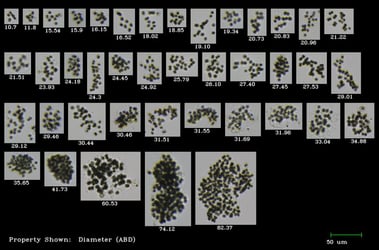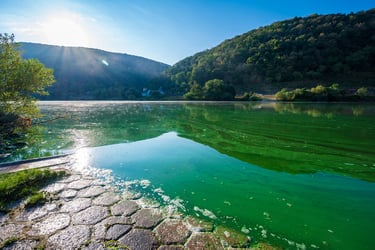 7 Lakes Alliance is a conservation organization with a mission to safeguard the Belgrade Lakes Region by preserving clean water, protecting local wildlife, and serving the Central Maine community whose lives and livelihoods are interwoven with the surrounding ecosystem. Their specific goals include protecting shorelines, preventing erosion, monitoring water quality, and managing invasive aquatic species.
7 Lakes Alliance is a conservation organization with a mission to safeguard the Belgrade Lakes Region by preserving clean water, protecting local wildlife, and serving the Central Maine community whose lives and livelihoods are interwoven with the surrounding ecosystem. Their specific goals include protecting shorelines, preventing erosion, monitoring water quality, and managing invasive aquatic species.
Dr. Danielle Wain, Lake Science Director at 7 Lakes Alliance, leads the water quality monitoring research program, where she leverages her background in civil and environmental engineering to better understand how hydrodynamics impact the ecology and biogeochemistry of the Belgrade Lakes and then uses this knowledge to develop water quality management strategies.
Dr. Wain is one of the operators of 7 Lakes Alliance’s new FlowCam Cyano, acquired in 2023. We recently connected with Dr. Wain to learn more about how she and her colleagues are using flow imaging microscopy to enhance their research and monitoring efforts and some of the challenges that 7 Lakes Alliance faces.
7 Lakes Alliance’s Introduction to FlowCam
7 Lakes Alliance has had a long-standing research partnership with Colby College and has been sharing the use of a FlowCam VS instrument with the college since 2012. Every summer, 7 Lakes Alliance hosts a 10-week internship program where students come to learn about water quality monitoring and how to use FlowCam for the detection of cyanobacteria. In 2023, 7 Lakes Alliance decided to purchase their own instrument – FlowCam Cyano – a fluorescence-based flow imaging microscope that functions like a flow cytometer by using laser excitation to image and identify cyanobacteria and automatically differentiate them from algae and other particles.
How FlowCam is Used Today
With 10 different sampling sites, there simply isn’t enough time for the 7 Lakes scientists to evaluate and analyze the water samples using manual microscopy alone. Since North Pond has been problematic, weekly sampling with FlowCam paired with monthly analysis via microscope by a taxonomist provides the group with a good balance between efficiency and exactitude. FlowCam samples can be processed immediately without needing preservation, saving them a lot of time every week.
Algae Trends in the 7 Lakes
One lake under 7 Lakes Alliance's purview, North Pond, is a large, shallow, polymictic (non-stagnant) lake that, since 2018, has had a history of algal blooms that cause a green tinge to the water and make the lake nonideal for recreation. Before 2018, 7 Lakes Alliance analyzed the North Pond water biweekly but has since changed to a weekly sampling schedule to document and understand the blooms and their effect on the ecosystem.
 Using manual microscopy together with FlowCam, Dr. Wain and her colleagues have discovered that samples taken from North Pond in early June tend to reveal lots of curly Dolichospermum (pictured right). Early in the year, this species of Dolichospermum will bring phosphorus from sediments into the water column as they rise upward. When they release the phosphorus into the water, it makes the mineral available for the next stage of the bloom featuring a bright green linear species of Dolichospermum. When this round dies off, they again release phosphorus into the water leading to a third phase of the bloom.
Using manual microscopy together with FlowCam, Dr. Wain and her colleagues have discovered that samples taken from North Pond in early June tend to reveal lots of curly Dolichospermum (pictured right). Early in the year, this species of Dolichospermum will bring phosphorus from sediments into the water column as they rise upward. When they release the phosphorus into the water, it makes the mineral available for the next stage of the bloom featuring a bright green linear species of Dolichospermum. When this round dies off, they again release phosphorus into the water leading to a third phase of the bloom.
Weekly sampling has helped the team understand this biologically mediated phosphorus transport process. While reducing runoff from the watershed is vital for reducing phosphorus in the lake, addressing internal sources of phosphorus is necessary to break the cycle of blooms. Typically, the internal loading of phosphorus is thought to mostly come from geochemical processes that occur when water becomes anoxic in the deep parts of the lake.
Samples of the Dolichospermum species from the North Pond blooms have been sent to Bigelow Labs for genetic testing, where they have so far confirmed that the coiled species does not produce toxins. Immediate feedback from FlowCam has helped 7 Lakes Alliance determine when toxin testing is needed and provides enough of a window to warn the public about potential health risks.
FlowCam – an Important Member of the Team
Overall, FlowCam data plays a crucial role in 7 Lakes Alliance’s comprehensive watershed planning by providing insights into water quality, identifying harmful algal blooms, assessing ecological health, informing management strategies, tracking changes over time, and facilitating collaboration and stakeholder engagement. Since 2012, FlowCam has helped 7 Lakes’ scientists make informed decisions and implement effective measures to protect and manage the watershed resources.
7 Lakes Alliance’s recent upgrade to FlowCam Cyano has made the group’s job even easier. FlowCam Cyano is more powerful and simpler to use than their old FlowCam VS. The new instrument’s flow cell boasts a more robust design making it less prone to clogging and easier to clean. FlowCam Cyano's new design also incorporates an easier process to change out one objective for another. This results in it being easier for college interns to learn and use.
The newest version of VisualSpreadsheet software provides many improvements as well, including classification tools using fluorescence signals, which help streamline the identification process. FlowCam Cyano also provides higher-resolution images, allowing for better visualization and analysis of particles.
Undergraduate Research Students Love Working with FlowCam
FlowCam is uniquely suited for undergraduate research due to its user-friendly interface making it accessible to students with limited experience. FlowCam has strengthened the 7 Lakes Alliance internship program by providing hands-on learning opportunities in microscopy and algae identification, allowing students to actively participate in sample preparation, data collection, and analysis. FlowCam's rapid data acquisition capabilities enable students to generate meaningful results within a short period.
FlowCam has enhanced 7 Lakes Alliance’s baseline monitoring program and continues to support its mission to monitor and protect water quality across several lakes in Central Maine. To learn more about how FlowCam can support your water quality monitoring program, download our ebook, “The Ultimate Guide to Flow Imaging Microscopy for Aquatic Life Sciences”.












